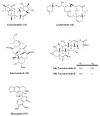Microtubule-stabilizing agents as potential therapeutics for neurodegenerative disease
- PMID: 24433963
- PMCID: PMC4076391
- DOI: 10.1016/j.bmc.2013.12.046
Microtubule-stabilizing agents as potential therapeutics for neurodegenerative disease
Abstract
Microtubules (MTs), cytoskeletal elements found in all mammalian cells, play a significant role in cell structure and in cell division. They are especially critical in the proper functioning of post-mitotic central nervous system neurons, where MTs serve as the structures on which key cellular constituents are trafficked in axonal projections. MTs are stabilized in axons by the MT-associated protein tau, and in several neurodegenerative diseases, including Alzheimer's disease, frontotemporal lobar degeneration, and Parkinson's disease, tau function appears to be compromised due to the protein dissociating from MTs and depositing into insoluble inclusions referred to as neurofibrillary tangles. This loss of tau function is believed to result in alterations of MT structure and function, resulting in aberrant axonal transport that likely contributes to the neurodegenerative process. There is also evidence of axonal transport deficiencies in other neurodegenerative diseases, including amyotrophic lateral sclerosis and Huntington's disease, which may result, at least in part, from MT alterations. Accordingly, a possible therapeutic strategy for such neurodegenerative conditions is to treat with MT-stabilizing agents, such as those that have been used in the treatment of cancer. Here, we review evidence of axonal transport and MT deficiencies in a number of neurodegenerative diseases, and summarize the various classes of known MT-stabilizing agents. Finally, we highlight the growing evidence that small molecule MT-stabilizing agents provide benefit in animal models of neurodegenerative disease and discuss the desired features of such molecules for the treatment of these central nervous system disorders.
Keywords: Axon; Microtubules; Neurodegeneration; Paclitaxel; Transport.
Copyright © 2014 Elsevier Ltd. All rights reserved.
Figures






Similar articles
-
Altered microtubule dynamics in neurodegenerative disease: Therapeutic potential of microtubule-stabilizing drugs.Neurobiol Dis. 2017 Sep;105:328-335. doi: 10.1016/j.nbd.2016.12.021. Epub 2016 Dec 22. Neurobiol Dis. 2017. PMID: 28012891 Free PMC article. Review.
-
The characterization of microtubule-stabilizing drugs as possible therapeutic agents for Alzheimer's disease and related tauopathies.Pharmacol Res. 2011 Apr;63(4):341-51. doi: 10.1016/j.phrs.2010.12.002. Epub 2010 Dec 14. Pharmacol Res. 2011. PMID: 21163349 Free PMC article.
-
A brain-penetrant triazolopyrimidine enhances microtubule-stability, reduces axonal dysfunction and decreases tau pathology in a mouse tauopathy model.Mol Neurodegener. 2018 Nov 7;13(1):59. doi: 10.1186/s13024-018-0291-3. Mol Neurodegener. 2018. PMID: 30404654 Free PMC article.
-
Epothilone D improves microtubule density, axonal integrity, and cognition in a transgenic mouse model of tauopathy.J Neurosci. 2010 Oct 13;30(41):13861-6. doi: 10.1523/JNEUROSCI.3059-10.2010. J Neurosci. 2010. PMID: 20943926 Free PMC article.
-
Non-Naturally Occurring Small Molecule Microtubule-Stabilizing Agents: A Potential Tactic for CNS-Directed Therapies.ACS Chem Neurosci. 2017 Jan 18;8(1):5-7. doi: 10.1021/acschemneuro.6b00384. Epub 2016 Nov 29. ACS Chem Neurosci. 2017. PMID: 28095679 Free PMC article. Review.
Cited by
-
Evaluation of N- and O-Linked Indole Triazines for a Dual Effect on α-Synuclein and Tau Aggregation.ACS Chem Neurosci. 2023 Nov 1;14(21):3913-3927. doi: 10.1021/acschemneuro.3c00464. Epub 2023 Oct 11. ACS Chem Neurosci. 2023. PMID: 37818657 Free PMC article.
-
Reduced Adrenomedullin Parallels Microtubule Dismantlement in Frontotemporal Lobar Degeneration.Mol Neurobiol. 2018 Dec;55(12):9328-9333. doi: 10.1007/s12035-018-1079-8. Epub 2018 Apr 18. Mol Neurobiol. 2018. PMID: 29671277
-
Brain-Penetrant Triazolopyrimidine and Phenylpyrimidine Microtubule Stabilizers as Potential Leads to Treat Human African Trypanosomiasis.ChemMedChem. 2018 Sep 6;13(17):1751-1754. doi: 10.1002/cmdc.201800404. Epub 2018 Aug 7. ChemMedChem. 2018. PMID: 29969537 Free PMC article.
-
Brain-penetrant, orally bioavailable microtubule-stabilizing small molecules are potential candidate therapeutics for Alzheimer's disease and related tauopathies.J Med Chem. 2014 Jul 24;57(14):6116-27. doi: 10.1021/jm5005623. Epub 2014 Jul 3. J Med Chem. 2014. PMID: 24992153 Free PMC article.
-
Inverse correlation between Alzheimer's disease and cancer: implication for a strong impact of regenerative propensity on neurodegeneration?BMC Neurol. 2014 Nov 14;14:211. doi: 10.1186/s12883-014-0211-2. BMC Neurol. 2014. PMID: 25394409 Free PMC article.
References
-
- Dogterom M, Surrey T. Current opinion in cell biology. 2013;25:23. - PubMed
-
- Roy S, Zhang B, Lee VMY, Trojanowski JQ. Acta Neuropathologica. 2005;109:5. - PubMed
-
- Hirokawa N, Noda Y. Physiological reviews. 2008;88:1089. - PubMed
-
- Ishikawa T. Journal of structural biology. 2012;179:229. - PubMed
-
- Desai A, Mitchison TJ. Annual review of cell and developmental biology. 1997;13:83. - PubMed
Publication types
MeSH terms
Substances
Grants and funding
LinkOut - more resources
Full Text Sources
Other Literature Sources
Medical

